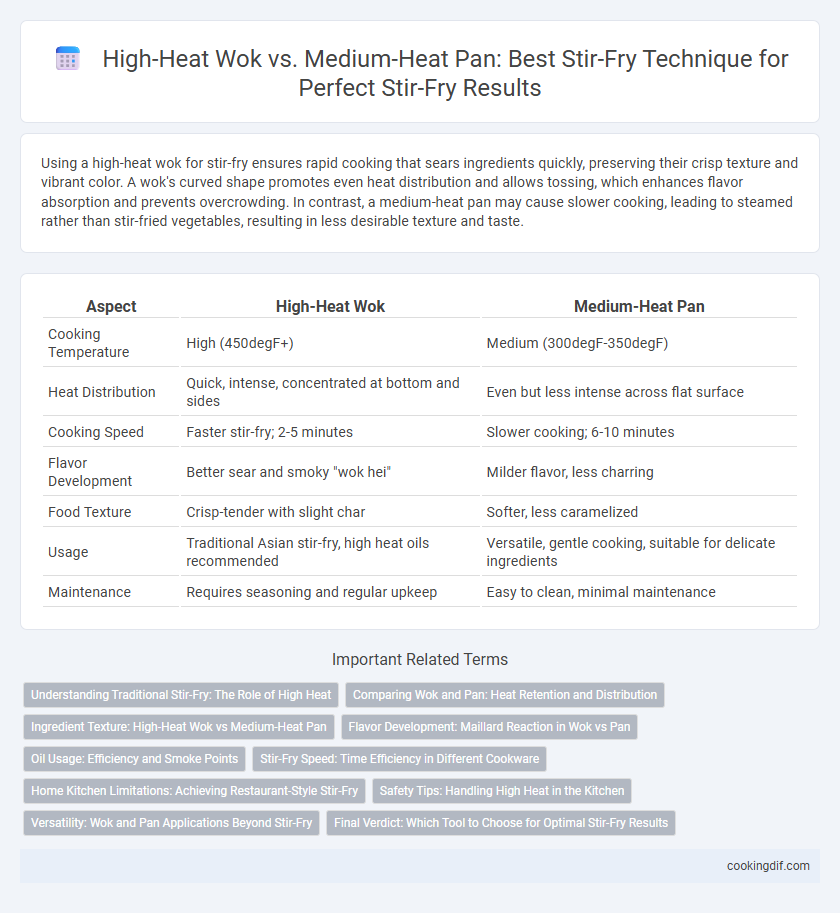Using a high-heat wok for stir-fry ensures rapid cooking that sears ingredients quickly, preserving their crisp texture and vibrant color. A wok's curved shape promotes even heat distribution and allows tossing, which enhances flavor absorption and prevents overcrowding. In contrast, a medium-heat pan may cause slower cooking, leading to steamed rather than stir-fried vegetables, resulting in less desirable texture and taste.
Table of Comparison
| Aspect | High-Heat Wok | Medium-Heat Pan |
|---|---|---|
| Cooking Temperature | High (450degF+) | Medium (300degF-350degF) |
| Heat Distribution | Quick, intense, concentrated at bottom and sides | Even but less intense across flat surface |
| Cooking Speed | Faster stir-fry; 2-5 minutes | Slower cooking; 6-10 minutes |
| Flavor Development | Better sear and smoky "wok hei" | Milder flavor, less charring |
| Food Texture | Crisp-tender with slight char | Softer, less caramelized |
| Usage | Traditional Asian stir-fry, high heat oils recommended | Versatile, gentle cooking, suitable for delicate ingredients |
| Maintenance | Requires seasoning and regular upkeep | Easy to clean, minimal maintenance |
Understanding Traditional Stir-Fry: The Role of High Heat
High-heat woks rapidly sear ingredients, preserving crisp textures and vibrant flavors essential in traditional stir-fry dishes like Kung Pao chicken and beef with broccoli. Medium-heat pans cook more slowly, often resulting in steamed rather than stir-fried textures and less pronounced Maillard browning. Mastery of traditional stir-fry techniques relies on the intense heat of a wok to achieve quick cooking that locks in nutrients and enhances natural umami profiles.
Comparing Wok and Pan: Heat Retention and Distribution
A high-heat wok excels in heat retention and rapid heat distribution, enabling quick searing and maintaining consistent temperature throughout the stir-fry process. In contrast, a medium-heat pan heats more slowly and often has uneven heat zones, which can result in uneven cooking and less efficient stir-fry performance. Woks made of carbon steel or cast iron optimize thermal conductivity, while standard pans typically lack the design for sustained high-temperature cooking essential in authentic stir-fry techniques.
Ingredient Texture: High-Heat Wok vs Medium-Heat Pan
A high-heat wok sears ingredients quickly, preserving crisp edges and a tender interior, enhancing the characteristic bite of stir-fry vegetables and proteins. In contrast, a medium-heat pan cooks more slowly, often resulting in softer textures and less caramelization, which can diminish the overall flavor depth. Thus, high heat is essential for achieving the ideal balance of crunch and tenderness in authentic stir-fry dishes.
Flavor Development: Maillard Reaction in Wok vs Pan
High-heat woks generate intense temperatures above 500degF, accelerating the Maillard reaction that creates complex flavors and crisp textures in stir-fry dishes. Medium-heat pans, typically heating up to 350-400degF, produce milder browning and less pronounced caramelization, resulting in subtler flavor profiles. The intense searing from wok heat enhances umami-rich compounds, making it superior for achieving authentic, robust stir-fry flavors.
Oil Usage: Efficiency and Smoke Points
High-heat woks require less oil due to their intense heat rapidly searing ingredients, preserving nutrients and texture while minimizing oil absorption. Medium-heat pans need more oil to prevent sticking, which can increase calorie content and affect flavor profiles. Woks also reach higher smoke points quickly, enhancing efficiencies in oil usage and reducing the risk of burning compared to medium-heat pans.
Stir-Fry Speed: Time Efficiency in Different Cookware
High-heat woks rapidly sear ingredients using temperatures often exceeding 400degF, significantly reducing stir-fry cooking time by promoting quick caramelization and preserving texture. Medium-heat pans typically operate around 300-350degF, leading to slower ingredient turnover and extended cooking times, which can result in less crisp outcomes. Choosing a high-heat wok enhances time efficiency and flavor development in stir-fry dishes compared to medium-heat pans.
Home Kitchen Limitations: Achieving Restaurant-Style Stir-Fry
High-heat woks deliver rapid heat distribution essential for authentic stir-fry textures, while medium-heat pans in home kitchens often struggle to reach or maintain the necessary temperatures, resulting in less crisp vegetables and unevenly cooked protein. Limited stove output and smaller pan surfaces restrict the Maillard reaction, a key to the signature sear and caramelization in restaurant dishes. Optimizing pan material and preheating techniques can partly bridge the gap, but replicating professional wok conditions at home remains challenging due to heat intensity and airflow differences.
Safety Tips: Handling High Heat in the Kitchen
Using a high-heat wok for stir-fry demands careful handling to prevent burns and flare-ups, so always preheat the wok gradually and use long-handled utensils to keep hands safe. Medium-heat pans reduce the risk of overheating, but it's essential to monitor oil temperature closely to avoid smoking or fire hazards. Always keep a fire extinguisher nearby and never leave high heat unattended to ensure kitchen safety.
Versatility: Wok and Pan Applications Beyond Stir-Fry
High-heat woks excel in rapid cooking techniques like stir-frying, searing, and deep-frying due to their unique shape and intense heat distribution, making them ideal for Asian cuisine and one-pan meals. Medium-heat pans offer versatility for sauteing, simmering, and pan-roasting, suitable for Western dishes and delicate ingredients requiring controlled cooking. Both tools enhance kitchen efficiency but vary in heat intensity and surface area, allowing chefs to select based on cooking style and dish complexity.
Final Verdict: Which Tool to Choose for Optimal Stir-Fry Results
High-heat wok offers superior heat retention and rapid temperature recovery, essential for achieving the characteristic sear and crispiness in stir-fry dishes. Medium-heat pans often fail to deliver consistent high temperatures, resulting in steaming rather than searing, which compromises texture and flavor. For optimal stir-fry results, a high-heat wok is the preferred tool due to its efficient heat distribution and ability to maintain intense cooking temperatures.
High-heat wok vs medium-heat pan for stir-fry technique Infographic

 cookingdif.com
cookingdif.com